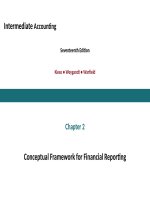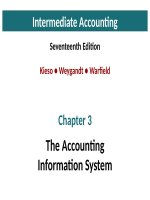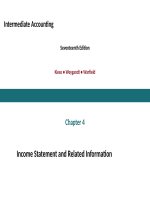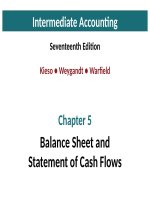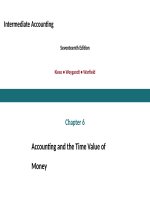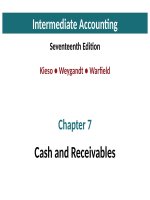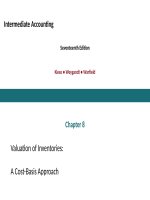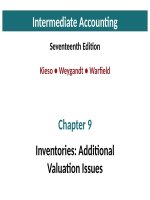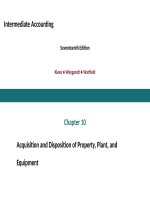Intermediate accounting 17e by kieso ch05
Bạn đang xem bản rút gọn của tài liệu. Xem và tải ngay bản đầy đủ của tài liệu tại đây (3.17 MB, 106 trang )
Intermediate Accounting
Seventeenth Edition
Kieso ● Weygandt ● Warfield
Chapter 5
Balance Sheet and
Statement of Cash Flows
This slide deck contains animations. Please disable animations if
they cause issues with your device.
Learning Objectives
After studying this chapter, you should be able to:
1. Explain the uses and limitations of the balance sheet.
2. Prepare a classified balance sheet.
3. Explain the purpose, content, and presentation of the
statement of cash flows.
4. Describe additional types of information provided.
Copyright ©2019 John Wiley & Sons, Inc.
2
Preview of Chapter 5
Balance Sheet and Statement of Cash Flows
Balance Sheet
• Usefulness
• Limitations
• Classification
Preparation of the Balance Sheet
• Account form
• Report form
Copyright ©2019 John Wiley & Sons, Inc.
3
Preview of Chapter 5
Statement of Cash Flows
• Purpose
• Content
• Preparation
• Usefulness
Additional Information
• Notes to the financial statements
• Techniques of disclosure
Copyright ©2019 John Wiley & Sons, Inc.
4
Learning Objective 1
Explain the Uses, Limitations, and
Content of the Balance Sheet
LO 1
Copyright ©2019 John Wiley & Sons, Inc.
5
Balance Sheet
Balance Sheet, sometimes referred to as the statement
of financial position:
1. Reports assets, liabilities, and equity at a specific
date.
2. Provides information about resources, obligations to
creditors, and equity in net resources.
3. Helps in predicting amounts, timing, and uncertainty
of future cash flows.
LO 1
Copyright ©2019 John Wiley & Sons, Inc.
6
Balance Sheet
Usefulness of the Balance Sheet
• Computing rates of return
• Evaluating capital structure
• Assess risk and future cash flows
• Analyze the company’s:
LO 1
Liquidity
Solvency
Financial flexibility
Copyright ©2019 John Wiley & Sons, Inc.
7
Balance Sheet
Limitations of the Balance Sheet
1. Most assets and liabilities are reported at historical
cost
2. Use of judgments and estimates
3. Many items of financial value are omitted
LO 1
Copyright ©2019 John Wiley & Sons, Inc.
8
Balance Sheet
Classification in the Balance Sheet
Elements of The Balance Sheet
1. Assets. Probable future economic benefits obtained
or controlled by a particular entity as a result of past
transactions or events.
2. Liabilities. Probable future sacrifices of economic
benefits arising from present obligations of a
particular entity to transfer assets or provide services
to other entities in the future as a result of past
transactions or events.
LO 1
Copyright ©2019 John Wiley & Sons, Inc.
9
Classification in the Balance Sheet
Elements of the Balance Sheet
3. Equity. Residual interest in the assets of an entity that
remains after deducting its liabilities. In a business
enterprise, the equity is the ownership interest.
LO 1
Copyright ©2019 John Wiley & Sons, Inc.
10
Classification in the Balance Sheet
Assets
Current assets
Long-term investments
Property, plant, and equipment
Intangible assets
Other assets
Liabilities and Owners' Equity
Current liabilities
Long-term debt
Owners' (stockholders') equity
Blank
Blank
In practice you usually see little departure from these major
subdivisions.
LO 1
Copyright ©2019 John Wiley & Sons, Inc.
11
Classification in the Balance Sheet
Current Assets
Cash and other assets a company expects to convert into
cash, sell, or consume either in one year or in the
operating cycle, whichever is longer.
Item
Cash and cash equivalents
Short-term investments
Receivables
Inventories
Fair value
Generally, fair value
Estimated amount collectible
Lower-of-cost-or-net realizable value/market
Prepaid expenses
Cost
LO 1
Basis of Valuation
Copyright ©2019 John Wiley & Sons, Inc.
12
Current Assets
Cash
• Generally any monies available “on demand”
• Cash equivalents - short-term highly liquid
investments that mature within three months or less
• Restrictions or commitments must be disclosed
LO 1
Copyright ©2019 John Wiley & Sons, Inc.
13
Cash
Balance Sheet Presentation
LO 1
Copyright ©2019 John Wiley & Sons, Inc.
14
Current Assets
Short-Term Investments (Equity Securities)
All equity securities are recorded at fair value with
changes reported in net income unless:
• Accounted for under equity method or
• Not practicable to determine fair value
LO 1
Copyright ©2019 John Wiley & Sons, Inc.
15
Current Assets
Short-Term Investments (Debt Securities)
Three separate classifications for debt securities:
Held-to-maturity: Company has positive intent and ability
to hold to maturity.
Trading: Bought and held primarily for sale in the near
term to generate income on short-term price differences.
Available-for-sale: Not classified as held-to-maturity or
trading securities.
LO 1
Copyright ©2019 John Wiley & Sons, Inc.
16
Short-Term Investments
Balance Sheet Presentation
LO 1
Copyright ©2019 John Wiley & Sons, Inc.
17
Current Assets
Receivables
Major categories of receivables should be shown in the
balance sheet or the related notes.
A company should clearly identify
• Anticipated loss due to uncollectibles
• Amount and nature of any nontrade receivables
• Receivables used as collateral
LO 1
Copyright ©2019 John Wiley & Sons, Inc.
18
Receivables
Balance Sheet Presentation
LO 1
Copyright ©2019 John Wiley & Sons, Inc.
19
Current Assets
Inventories
Disclose
• Basis of valuation
Lower-of-cost-or-net realizable value or
Lower-of-cost-or-market
• Cost flow assumption (e.g., F I F O or L I F O)
LO 1
Copyright ©2019 John Wiley & Sons, Inc.
20
Inventories
Balance Sheet Presentation (Acer)
LO 1
Copyright ©2019 John Wiley & Sons, Inc.
21
Inventories
Balance Sheet Presentation (Weyerhaeuser)
LO 1
Copyright ©2019 John Wiley & Sons, Inc.
22
Current Assets
Prepaid Expenses
Payment of cash, that is recorded as an asset because
service or benefit will be received in the future.
Cash Payment Before Expense Recorded
Prepayments often occur in regard to:
• insurance
• rent
• supplies
• taxes
• advertising
LO 1
Copyright ©2019 John Wiley & Sons, Inc.
23
Prepaid Expenses
Balance Sheet Presentation
LO 1
Copyright ©2019 John Wiley & Sons, Inc.
24
Current Assets
Illustration
BE5.2 Koch Corporation’s adjusted trial balance contained the
following asset accounts at December 31, 2020: Cash $7,000,
Land $40,000, Patents $12,500, Accounts Receivable $90,000,
Prepaid Insurance $5,200, Inventory $30,000, Allowance for
Doubtful Accounts $4,000, and Equity Investments (to be sold
in the next quarter) $11,000.
Prepare the current assets section of the balance sheet, listing
the accounts in proper sequence.
LO 1
Copyright ©2019 John Wiley & Sons, Inc.
25
